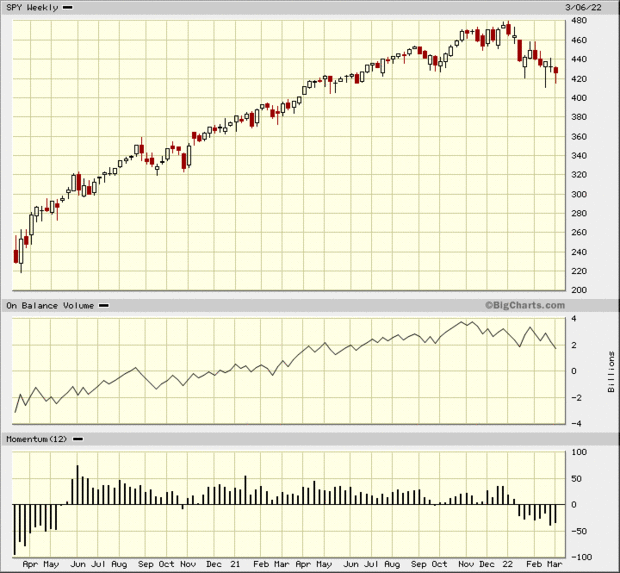Is it over?
The S&P 500 (SPY) is up over 5% since its low on March 12, and the NASDAQ 100 has performed even better, rallying over 7%. The gains are encouraging, but investors should remember this isn't the first time the market indexes have moved significantly higher this year. We saw similarly strong returns in late February only to watch in dismay as markets rolled over to make new closing lows this month.
If the market's frenetic behavior has you scratching your head, wondering if the bottom is finally in, you're not alone. We're here to help. To make sense of it all, we asked some of TheStreet's top analysts for their opinion. Read on to learn what they had to say about the markets.
Doug Kass, Hedge Fund Manager and Author of Real Money Pro's Daily Diary:
The truthful answer to the question is that nobody knows for sure.
On the positive side of the equation is that:
- So many stocks have declined materially. For example, over 50% of the Nasdaq stocks are down by fifty percent.
- The "known unknowns" - slowing global growth, sticky inflation, high valuations, geopolitical risks, and a more hawkish Fed is well known by most market participants.
- Corporations are flush with cash and are relatively positioned to endure a downturn.
- Due to strong balance sheets, corporate buybacks will be a continuing event.
- As my friend Byron Wien says, "disasters have a way of not happening."
On the other hand, the negatives are:
- A Fed pivot towards higher rates has been historically bearish for stocks.
- It will be challenging for corporations to maintain margins and profitability given slowing economic growth and persistent inflation.
- Globalization is over, and nationalism is here - higher sourcing costs threaten corporate profits.
- We do not face a monetary problem; we face a supply chain problem.
- Should the Ukraine conflict continue, essential supply chains are likely to stay disrupted, and, as a result, inflationary pressures will not likely abate.
The negatives outweigh the positives from my perch.
Whether or not the market moves lower - and makes a new bottom - can be debated. But what is not likely debatable is that we are in a new regime of heightened volatility and a bull market in uncertainty.
(Read Doug Kass's Daily Diary every trading day on Real Money Pro, TheStreet's premium site. Click here to learn about this dynamic market information service for active traders.)
Real Money's James 'Rev Shark' DePorre:
This question is complicated because we have undergone a very unusual market correction. As I've discussed extensively on RealMoney.com, there has been a stealth bear market in small caps, growth stocks, biotechnology, SPAC-related, cannabis, and various other stocks. In contrast, big caps and indices have held up reasonably well. In recent weeks, the indices and big caps have finally started to catch up with the stocks that have already corrected deeply.
I believe that the market bottom will be a reversal of this action and that there will be a stealth bull market in the many stocks that have been correcting since February 2021 while the indices and big caps underperform.
We are already starting to see some better charts and price action in the hardest-hit areas of the market. They are still struggling, but there are signs of relative strength, and there appears to be more focus on fundamentals and valuations.
I believe that investors focused on individual stock picking will find some outstanding stocks that are already close to a significant bottom.
(James "Rev Shark" DePorre provides market commentary and trading ideas throughout the day on Real Money, TheStreet's premium site. Click here to learn more.)
Chris Versace, Co-Portfolio Manager Action Alerts PLUS:
Uncertainty is a foe of the stock market. So far in 2022, we've had several uncertainties take hold. The biggest is the Russia-Ukraine war and the subsequent impact on key inputs and gas prices, raising concerns over consumer spending, a vital driver of the domestic economy. To that, we can add market concerns over the pace of interest rate hikes by the Federal Reserve and, more recently, the renewed supply chain concerns following the COVID-19 lockdown in China that has led to at least for now the closure of the manufacturing hub Shenzhen. Along with the halting of operations in Russia by companies and the impact of soaring commodity and other input prices, this shutdown is another factor that will lead investors to revisit revenue and earnings expectations for the current quarter. This is already happening, but the longer the war and ensuing sanctions last, the greater the revisions for the first half of 2022 are likely to be.
With the S&P 500 roughly 10% above its 52-week low of 3,863.50, some argue that we could re-test that level in the coming weeks as the true impact of the above factors is laid bare by the March quarter earnings season. However, suppose the latest comments from both Russia and Ukraine citing "progress" give rise to peace talk progress, and a path to ending the war and dialing back the sharp jump in commodity prices is the prevailing view. In that case, we'll have passed a major bump in the stock market road for 2022.
Ultimately, the stock market is a forward-looking animal. There have been many examples of that over the decades. The most recent example was when equities bottomed in March 2020 during the arguable pinnacle of COVID-19 inspired uncertainty only to rebound mightily as the realization that even though the global economy slowed substantially, it didn't come to a full stop. The same is likely to eventually play out in 2022, especially if the duration of the Russia-Ukraine war winds up being shorter than some expect.
At the Action Alerts Plus portfolio, we raised cash as the lead-up to the Russia-Ukraine war intensified. Now we are thoughtfully putting it back to work, taking advantage of the sharp falloff in the market to add to existing positions and establish new ones. Much like the market, even though we have one eye on the near-term, the other focuses on opportunities today that will play out over the coming 12-18 months.
(Chris Versace is Co-Portfolio Manager of TheStreet's Action Alerts PLUS. Click here to learn how to subscribe.)
Bret Jensen, Real Money Pro Contributor:
It has been a challenging start of 2022 for investors. And that's an understatement. The major indexes are all in "correction" territory. While they have stayed out of going into official bear markets, most of the overall market has already set up camp there. As of last week, over 45% of the Nasdaq components are down at least 50% from their 52-week highs. This isn't news to investors in speculative areas like biotech, software as a service, artificial intelligence, and electric vehicles. Even the mega-cap tech behemoths that led the rally in equities for years like Meta Platforms FB, Netflix NFLX, Tesla TSLA, and Apple AAPL have recently turned over.
So, do we have a pullback that investors should act upon and go bottom fishing at much lower entry points in a major way? That all depends on if one is an optimist or a pessimist.
Optimists may argue the situation in Ukraine resolves itself soon, the economy and the markets won't have a major hiccup due to the Federal Reserve hiking rates, global supply chain issues will improve, and inflation will moderate.
However, the pessimist's view is inflation, already at four-decade highs, continues to run at elevated levels, negatively impacting consumer confidence, sentiment, and behavior. Further, the market, economy or both convulse as the central bank starts tightening and higher cost inputs, continued problems with the supply chain, and a falloff in consumer demand negatively impact corporate profit margins and growth prospects. Also, Ukraine develops into a long and bloody conflict whose consequences can't possibly be known at this point.
My long-time readers know I will take a skeptical stance on this question.
To be an optimist, one must believe that government actions will effectively allay the core problems currently facing the economy. Put me in the Milton Friedman camp here, especially with the current administration that is in place.
Profit estimates for the S&P 500 have not come down since the invasion of Ukraine, but outside of energy, they should in the coming weeks. The S&P 500 currently sells for 19-times forward earnings. While that is down from 22 at the start of the year, it certainly is not near bargain territory as economic conditions continue to degrade. This is especially true with the yield on the 10-year Treasury rising to 2% and with interest rate hikes on the horizon. There may be bargains in the most beaten-down areas of equities, but the overall market is hardly in oversold territory.
(Bret Jensen is a regular contributor to Real Money Pro, the TheStreet's premium site, where he writes regularly about the market and the biotech sector. Click here to learn more.)
Bruce Kamich, Real Money Technical Analyst:
I have been asked a similar question for more years than I remember. "At what level has or will the stock market bottom?"
It's a fair question, but not always a simple one to answer.
But if you want a quick and dirty answer to whether the current market has bottomed yet, the answer is NO.
That does not mean there are not some trading opportunities in the short-run that will make it seem like we have hit bottom, but that does not make it a true bottom from my perspective and experience.
The level is not the issue and should not define a bottom. A market bottom is a process, and each one is a little different. Still, I believe there are common features to look for.
First, go back and read my 2022 forecast piece from Dec. 9. The market dynamics I saw at that time are not done playing out.
Second, let's look at some quick-turning candlestick patterns to see if they have picked up a bottom reversal with confirmation. There are some lower shadows in the following weekly chart, but that is not enough to give us an actionable reversal.

Some technical-oriented traders and analysts will tell you the market is oversold, but oversold/overbought indicators such as the stochastic indicator only work best in sideways markets. Once a market is trending, analysts need to switch gears to trending indicators.
Third, how many of the 11 sectors in the market have bottomed? Have 40% of the stocks made a bottom and turned higher within those sectors? Are stocks breaking downtrends or breaking up from bases? Big difference.
Fourth, have stocks been ignoring bearish news? Is the market ignoring bearish news, telling us bad news is discounted?
Lastly, what is the new leadership that often comes after a significant decline? Can energy, commodities, and defense stocks display enough leadership to lift the broader market? I don't think so.
Bottom-Line? The market can recover for a few weeks but then roll over and continue lower again. We have experienced some fearful days in the markets and seen some throw in the towel on individual stocks, but I have yet to see professionals and individual traders dump en masse. Maybe we will see things come together in the May-June time frame. We'll see.
(Read Bruce Kamich's technical analysis and recommendations each day on Real Money, TheStreet's premium site.)
TheStreet Smarts' Todd Campbell
Nobody knows if a long-term market bottom has been made until after it happens. But some clues can help you spot short-term bottoms, and there are reasons for optimism this week.
For example, only 22.5% of investors responding to AAII's weekly sentiment survey are bullish. The historical average is 38%, and AAII associates below 28% as unusually low. That's useful because low bullishness readings can be a contrary indicator signaling we can rally.
Also, the CBOE's total put-call options ratio has been trending higher all year, and this week, it was back above 1. That's helpful because bearish put buyers exceeding bullish call buyers can signal there's too much pessimism
Additionally, one of my internal indicators -- the percentage of actively-traded stocks trading over 5% above the 200-day moving average -- remains historically low. Currently, only 21% of the 1,600 stocks I track are 5% above the 200-day moving average. Historically, readings below 30% are actionable, and below 20% are really actionable.
Altogether, those factors suggest the market boat was tilted too much to one side, resulting in participants shifting the other way.
Those indicators only tell a short-term story, though. They don't guarantee a bounce will become the next big bull market, and bear markets are notorious for having rip-roaring rallies that peter out.
Perhaps, the most important thing for investors to remember is the old Wall Street adage, "Don't fight the Fed."
With inflation clocking in at 40-year highs, the Fed's no longer supporting cheap credit. That isn't good for economic growth and, thus, revenue, profits, and stock prices. If the Fed hikes too far, we could wind up in a recession.
It's not all bad news, though.
There's usually something in the market that's working. For example, baskets that do best in the late phase of the business cycle, such as energy, have been great this year. And sectors that do well in a recession, including healthcare and utilities, have been strong since late February.
Also, long-term investors might want to view the market's inevitable downturns more favorably than they do. Why? Because sell-offs provide opportunities to dollar-cost average into favorite investments at what often proves favorable prices.
As the famous investor Shelby Cullom Davis said, "You make most of your money in a bear market, you just don't realize it at the time."







